#5 West Indies v Australia, Barbados, 1999
Australia were not yet the indomitable unit they were to become in the next 7-8 years. However, Steve Waugh had an experienced squad brimming with confidence. Brian Lara, on the other hand, had numerous headaches to deal with. A 5-0 thrashing in South Africa was followed by a humbling loss in Trinidad. The peerless left hander had engineered a remarkable turnaround in Jamaica with a majestic 213 but Australia were still the better side going into the third Test in Barbados.
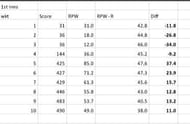
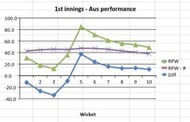
Australia’s performance in the 1st innings makes for an interesting analysis. They started poorly and their RPW fell way behind their RPW-R so much so that the difference (diff) was -36 at the fall of the 3rd wicket. A brief recovery was followed by a huge partnership that moved them into the ascendancy. The RPW at the fall of the 5th wicket was 85 and the diff was 37.4. Despite a few quick wickets at the end, their RPW was comfortably above the RPW-R at the end of the innings (diff of 11.0).
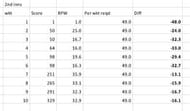
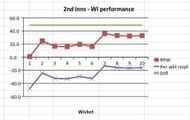
The hosts were already on the backfoot at the start of their 1st innings. Quickly, their grip on the match well and truly slipped away as their RPW crashed to 16.3 at the fall of the 6th wicket – a diff of -32.7. Solid knocks by Sherwin Campbell and Ridley Jacobs steadily lifted the RPW to 32.9 at the end of the innings. The diff, however, was still a substantial -16.1 going into the 3rd innings of the Test.
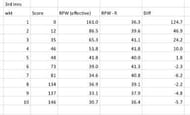
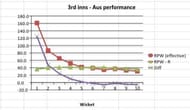
West Indies needed some inspiration. It came in the form of their bowlers. The visitors were in a terrible position when the 7th wicket fell (score at 81) but the big lead meant that the RPW was still a respectable 34.6, just 6.2 behind their RPW-R of 40.8 at that stage. A late charge threatened West Indies’ chances but was snuffed out quickly and the innings ended with an RPW of 30.7, a fall of 5.7 from their RPW-R. However, it was still well above what West Indies had ever achieved (RPW-R) in the ten years before the game.
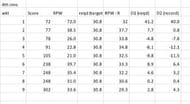
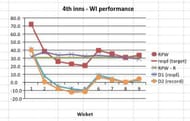
Despite a good start, the hosts’ batting crumbled to leave them with an RPW of 21 at the fall of the 5th wicket – well behind the RPW–R (32.5) and the RPW required (30.8). The D1 and D2 were -9.8 and -11.5 respectively. Lara, together with the resolute Jimmy Adams, stitched together a terrific stand for the 6th wicket and lifted the RPW to 39.7 when Adams fell to McGrath. At this stage, West Indies had boosted D1 and D2 to 8.9 and 6.4 respectively. Two quick wickets, however, brought the RPW down to 31 and the differences, D1 and D2 were just a shade above 0 (0.2 and 0.4). Lara, realizing that he had to do it all by himself now, took the game to the Australians.
With the plucky Ambrose for company, Lara lifted West Indies to an RPW of 37.7 and just six runs away from victory when Ambrose fell. At this stage, West Indies were still marginally ahead but with the rather unreliable batting of Walsh to come, the outlook was bleak. However, Walsh held on and Lara soon took West Indies home with a scorching drive through the covers. West Indies ended with an RPW of 34.5 which was well above what they had ever achieved in the ten years before this great Test. Given their dominant position in the match, Australia would probably feel that they lost out in their 2nd innings with a below-par batting display that gave West Indies a glimmer of hope. In the form he was in, Lara did not need a second chance.
Looking for fast live cricket scores? Download CricRocket and get fast score updates, top-notch commentary in-depth match stats & much more! 🚀☄️